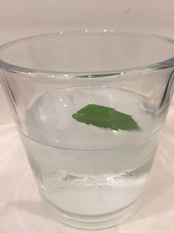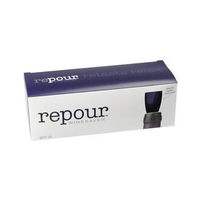|
|
 |
|
August 21, 2018
Four ingredients go into the making of traditional mint juleps: Bourbon, fresh mint, simple syrup, and crushed ice. The classic bourbon-based mint julep is today mostly synonymous with the Kentucky Derby, and was traditionally served in a silver or pewter cup. According to Wikipedia,  almost 120,000 juleps are served at Churchill Downs over the two-day period of the Kentucky Oaks (the race for 3-year old fillies--female horses--held every year on the day before the Derby). almost 120,000 juleps are served at Churchill Downs over the two-day period of the Kentucky Oaks (the race for 3-year old fillies--female horses--held every year on the day before the Derby).
I’ve never been to the Kentucky Derby, though I do try to make myself a classic julep every year on Derby day. More often, and especially during the hottest summer days, I prefer a lighter, more refreshing version of the tonic, substituting gin for the bourbon. And instead of simple syrup I like to top this cocktail off with a splash of tonic, which adds not only sweetness, but also a hint of refreshing fizz as well as a pleasing trace of bitterness.
I shake rather than stir the gin julep so as to extract a generous amount of the mint’s essential oils. As for the drinking vessel, I’ll take good glassware over metal any day. With or without a horse race, a gin julep is one of summer’s most refreshing cocktails.
6-8 fresh mint leaves, plus one for garnish
3 ounces gin
2 ounces tonic
Place the mint and gin in a shaker. Fill the shaker about ¾ full with ice cubes and shake it vigorously for at least 15 seconds. Strain the mixture into a glass, add a couple of ice cubes and the mint leaf, and drink immediately.
Cheers!
Posted by Marguerite Thomas at 1:26 PM
|
|
August 1, 2018
I’m often greeted with a snicker or two when bringing up the discussion of how to handle leftover wine. In fact, I think I can hear some of you right now: “Leftover wine? What’s that?” I realize that there are some among us that are serious practitioners of the “open means empty” ethos. However, many other consumers wish to moderate consumption by not polishing off an entire bottle, or prefer to retain a portion for a future occasion when the wine might provide a good food  match. Yet, until now, the span during which a wine could be saved but held in good condition was pretty short, or the devices that could prolong the span were prohibitively expensive. I’m pleased to report that the window has now been significantly and economically extended. match. Yet, until now, the span during which a wine could be saved but held in good condition was pretty short, or the devices that could prolong the span were prohibitively expensive. I’m pleased to report that the window has now been significantly and economically extended.
The repour™ winesaver is a stopper that--when inserted into a partially consumed bottle--purports to consume the oxygen in the air space, keeping the wine fresh in the same bottle until it is consumed, “even if taken glass by glass over days, weeks or months,” according to the packaging. Having tested myriad systems and gadgets over the years, my personal favorite method has been to pour half of a 750 ml bottle immediately upon opening into a 375ml bottle, top the 375 with a shot of argon (“Vineyard Fresh” or “Private Reserve” are brands) and set aside. I’ve had this method preserve a wine for about 30 days maximum, and probably for about two weeks on average. Looking to extend that period, I put the repour™ through a real-world test that some might regard as rather unscientific, but which was nevertheless quite telling.
I took three bottles that I reviewed favorably that had been open for about four hours (resulting in three different fill levels) and sealed them with the repour™ stopper on April 17, tasting them a few times over the course of three months. As of July 17, all three wines are still going strong after opening and resealing over that time. In fact, my senses tell me that the device makes the wine go a touch anaerobic, meaning it closes up slightly. A little swirl time in the glass gets some oxygen back in and reawakens the wine. This occurrence is noted on the product box, and it rings true.  Bottom line: each of the three wines I used as test subjects are showing as fresh as the day I scored them. The product is available in boxes holding 4, 10 or 72 stoppers, retailing between $2.25 and $1.67 per stopper, based on quantity purchased, at repour.com. Bottom line: each of the three wines I used as test subjects are showing as fresh as the day I scored them. The product is available in boxes holding 4, 10 or 72 stoppers, retailing between $2.25 and $1.67 per stopper, based on quantity purchased, at repour.com.
Possible uses for these stoppers extend well beyond the homes of consumer here. A restaurant by-the-glass program could benefit greatly from them, potentially broadening the selection of wines that might be offered, and possibly lowering costs, which could be good for proprietors and customers alike.
If you’ve grown tired of pouring your favorite wines--and your money down the drain, try a box of these babies--you’ll be glad you did.
Posted by Rich Cook at 4:25 PM
|
|
 |
|